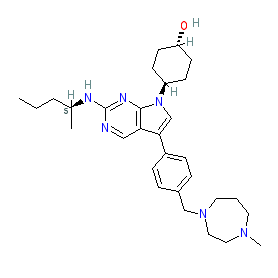GtoPdb is requesting financial support from commercial users. Please see our sustainability page for more information.
|
Synonyms: MERTK inhibitor 19 [PMID: 30347155] | UNC4203A [US20150291606A1]
Compound class:
Synthetic organic
Comment: The structure and activity of UNC4203 is disclosed in Zhao et al. (2018) [4] and we rendered the structure using the SMILES string provided therein. It is one of the chemical structures claimed in patent US20150291606A1 [3], with therapeutic uses of such compounds claimed in WO2015157125A1 [2].
Ligand Activity Visualisation ChartsThese are box plot that provide a unique visualisation, summarising all the activity data for a ligand taken from ChEMBL and GtoPdb across multiple targets and species. Click on a plot to see the median, interquartile range, low and high data points. A value of zero indicates that no data are available. A separate chart is created for each target, and where possible the algorithm tries to merge ChEMBL and GtoPdb targets by matching them on name and UniProt accession, for each available species. However, please note that inconsistency in naming of targets may lead to data for the same target being reported across multiple charts. ✖ |
|
|||||||||||||||||||||||||||||||||||
| Immunopharmacology Comments |
| MERTK is one of the members of the TAM family of tyrosine kinases. It plays important roles in the innate immune system including the regulation of self-tolerance and inhibition of autoimmunity. In the tumour microenvironment TAM kinase activity (e.g. from tumour infiltrating macrophages) can undermine any antitumoral immune response and augment cancer progression. Subsequently, MERTK inhibition has been shown to inhibit tumour growth and metastasis in experimental models [1], and the development of MERTK inhibitors with potential as immuno-oncology therapeutics is underway. UNC4203 is a suitably selective pharmacological tool to examine the potential of MERTK inhibition as an immunomodulatory mechanism and to aid futher elucidation of MERTK's role in cancer immunology. |








